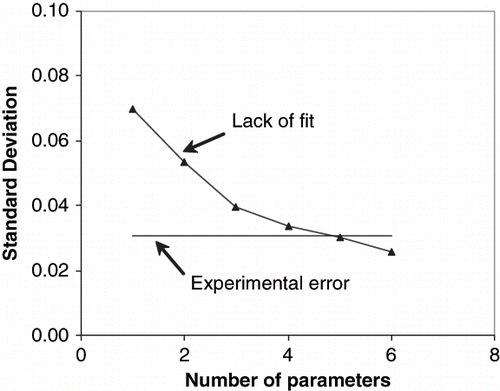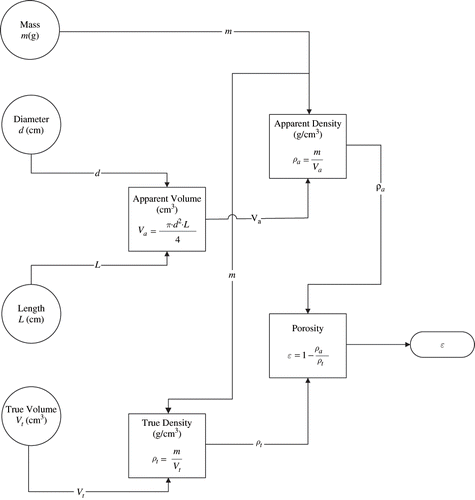Abstract
The effect of extrusion conditions, including feed rate (2.52–6.84 kg/h), feed moisture content (13–19% wet basis), screw speed (150–250 rpm), and extrusion temperature (150–230°C) on structural properties of corn-legume based extrudates was studied. Four different types of legumes, chickpea, mexican bean, white bean, and lentil were used to form mixtures with corn flour in a ratio ranging from 10 to 90% (corn/legume). A simple power model was used to correlate porosity with extrusion conditions and material characteristics. The influence of feed rate in the extrudates porosity is incorporated into mean residence time. Porosity of extrudates was found to increase with temperature and residence time and to decrease with feed moisture content and corn to legume ratio. Screw speed did not affect extrudates properties. Expansion ratio showed a similar behavior with porosity. The addition of legumes (protein source) led to more dense products. Comparatively, the usage of white bean in mixtures for the production of snacks, led to a product with higher porosity than those with other legumes.
INTRODUCTION
In recent years several studies have suggested that a Mediterranean diet has many benefits in human health. It is associated with lower incidence of cardiovascular disease and cancer via a variety of mechanisms, including improved blood lipid profile, decreased lipid oxidation, antithrombotic, and anti-inflammatory effects, improvement in endothelial function, and decreased insulin resistance and ventricular irritability.[Citation1–3] The Mediterranean diet includes: high monounsaturated: saturated fat ratio, moderate consumption of ethanol, milk and dairy products, low consumption of meat and meat products and high consumption of cereals, fruits, vegetables, and legumes. Legumes are generally good sources of slow release carbohydrates and rich in proteins and dietary fibers. Legumes are normally consumed after processing, which not only improves palatability of foods but also increases the bioavailability of nutrients, by inactivating trypsin inhibitors and haemagglutinins. Starch, the major biopolymeric constituent of legumes, upon processing gets partially modified into resistant starch.[Citation4]
The increasing demand for all types of non-meat, high-protein products has resulted in new and highly profitable ventures for food manufacturers. Proteins derived from plant sources are becoming one of the food industry's fastest-growing and most-innovative ingredient segments. Plant proteins have increased functionality, a bland flavor profile, additional nutritional benefits, and a low-cost advantage as both meat extenders and meat alternatives. Legumes, with their high amount of protein (∼18–25%) can be considered as the best and the cheapest source of plant protein. Although there are several methods for processing plant proteins into texturized products, the use of twin-screw extrusion cooking has proven to be instrumental in the development of many new industry opportunities.
Extrusion cooking is unique among heat processes in that the material is subjected to intense mechanical shear; moistened starchy or proteinaceous foods are worked into a viscous, plastic-like dough and cooked before being forced through the die. The intense structural disruption and mixing facilitates reactions otherwise limited by diffusion of reactants and products.[Citation5] Some results of cooking during the extrusion process are the gelatinization of starch, denaturation of proteins, inactivation of many native enzymes, which causes food deterioration during storage, inactivation of antinutrient factors,[Citation6–8] and reduction of microbial counts in the final product.[Citation9] Product quality can vary considerably depending on the extrusion processing conditions such as extruder type, screw configuration, feed moisture, temperature profile in the barrel sections, screw speed, and feed rate. The influence of processing conditions on the product quality by extrusion of starch based and starch-legumes blends has been investigated.[Citation10–19]
Pores occur in diverse food products, such as cakes, breads, and biscuits, breakfast cereals, fried, dried, and extruded products. During drying the pore formation has been studied widely and many investigators have proposed empirical models for porosity prediction.[Citation20–22] The shrinkage or expansion of food during drying is expressed by shrinkage-expansion coefficient.[Citation21] In extrusion cooking, expansion is the primary quality parameter associated with product crispiness, water absorption, water solubility, and crunchiness. Extrudate expansion can be expressed through porosity and expansion ratio. During extrusion cooking of biopolymers, the viscoelastic material is forced through the die so that the sudden pressure drop causes part of the water to vaporize, giving an expanded porous structure. The resulting extrudate expansion has extrusion contributions from both elastic swell and bubble growth effects.[Citation23] The bubble growth rate is modelled, in the bubble growth theory.[Citation24] A general model of extrudate expansion has been developed including the radial, longitudinal and volumetric expansion.[Citation25] Extrudate expansion has been reported to be most dependent on material moisture content and extrusion temperature. Several theoretical considerations for extrudate expansion have been published.[Citation24–27]
The objective of this study was to investigate porosity and expansion ratio changes of four corn-legumes mixtures (including chickpea, mexican bean, white bean, and lentil) as a function of process conditions (temperature, feed rate, screw speed) and material characteristics (moisture content, corn to legume ratio). A simple mathematical model was developed, to predict porosity as a function of process conditions and material characteristics.
MATHEMATICAL MODELING
Mathematical Model
In order to examine the influences of process conditions and material characteristics on the porosity, a simple power model is used. The proposed equation is:
The porosity influencing of process conditions, such as, product temperature, residence time and screw speed is expressed by n T , n τ, n N exponents, respectively, while the influence of material characteristics such as feed moisture content and corn to legume ratio is expressed by n x and n c exponents, respectively.
The influence of feed rate in the extrudates porosity is incorporated into mean residence time, considering that mean residence time is:
Extrudates were assumed to have very low levels of moisture content, so their structural properties—namely true density, apparent density, and porosity—are similar to the structural properties of dried materials at zero moisture content. Therefore, the true density of extrudates, ρ t , is equal to the density of solid material and it is assumed constant.
It is expected that not all of these parameters will influence to the same degree the porosity of extrudates, and this can be revealed through regression analysis.
Regression Analysis
The values of the required parameters are determined by fitting the proposed model to the experimental data. This can be done by minimizing the following residual sum of squares:
The resulting model is considered acceptable if the standard deviation between experimental and predicted values (lack of fit, S R ) is close to the experimental error (S E ).
The standard deviation between experimental and predicted values (S R ) and the standard experimental error (S E ) can be calculated from the following equations:
Following regression analysis procedure, all 6 parameters can be determined simultaneously. However, all of these parameters do not affect the sum of squares of the residuals to the same degree. In order to distinguish between the ones that are necessary to accurately predict the porosity, the following procedure was adopted. Firstly the minimum change in sum of squares (SST) was estimated for all six parameters and mean deviation (S R ) was evaluated. Secondly, omitting one parameter at a time, the values of S R was evaluated for all combinations of the five remaining parameters. In this way, the parameter chosen to be eliminated was the one whose elimination produced the minimum S R . Continuing the former procedure, the minimum values of S R was evaluated for 4, 3, 2, and 1 parameters, respectively. In , it is shown a typical figure of S R and S E as a function of the number of parameters. The group of parameters which gives a lack of fit (S R ) close to mean experimental error (S E ) is the one that involves the required number of parameters for predicting porosity.
MATERIALS AND METHODS
Sample Preparation
Yellow corn flour was mixed with legume flour (chickpea, mexican bean, white bean, and lentil) and 0.5% salt. Material characteristics are shown in . Distilled water was added to adjust moisture content. All the ingredients of each preparation were mixed in a mixer for 15 min, to ensure homogenous mixture. After mixing, the samples were packed under vacuum and stored. The proximate composition of materials used is shown in .
Table 1 Extrusion conditions and material characteristics
Table 2 Chemical composition of raw materials (g/100g)
Extrusion Cooking
A prism Eurolab conical, counter-rotating twin screw extruder, model KX-16HC, was used. The general screw geometry was: length 40 cm, diameter 16 mm, maximum rotation speed 500 rpm, and die diameter 3 mm. The material was fed into extruder with a volumetric feeder. The extruder had 5 temperature control zones. The pressure at the die during extrusion was measured with a pressure transducer. All extrusion conditions were displayed on the control panel (barrel and screw die temperature, screw speed). The temperature during extrusion was adjusted by varying the temperature in the barrel, screw and die. The extrusion conditions are shown in . Steady state conditions were reached after 20 min, and then samples collected dried in air and stored for further structural properties measurement.
Residence time is calculated using EquationEq. (2). The empty fraction has been correlated with extrusion conditions and it is given by the following equation, which is used for this extruder type:
Measurement of Porosity and Expansion Ratio
The porosity of the extrudates was determined from the true and apparent density, using the equation:
The apparent density was determined by measuring the actual dimensions of the extrudates.[Citation28] The diameter of extrudates was measured with a Vernier caliper. The apparent density of extrudates was determined using the equation:
RESULTS AND DISCUSSION
The application of regression analysis for each type of sample showed that the optimum number of parameters which affect porosity is 5 (). These parameters were ε 0 , n T , n τ, n X , n C . The screw rotation speed did not affect significantly the porosity of extrudates. In , experimental and predicted values of porosity are listed. A comparison between predicted porosity and experimental data is shown in to . The corresponding parameter estimates for all materials are shown in . In , porosity of extrudates is represented as a function of mean residence time, feed moisture content, extrusion temperature and corn to legume ratio. Solid lines are used for predicted values of porosity using the mathematical model and the parameters of .
Table 3 Experimental and predicted porosity of extrudates
Table 4 Results of parameter estimation
Figure 3 Porosity of extrudates as a function of residence time and temperature (CP: corn/chickpea; CM: corn/mexican bean; CB: corn/white bean; CL: corn/lentil).
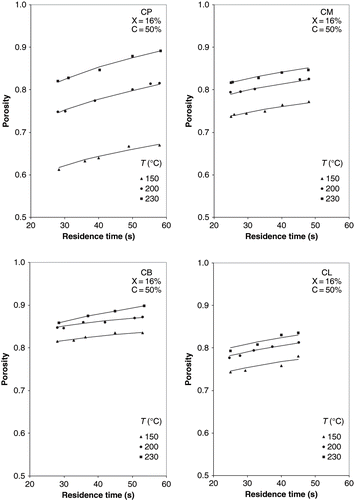
Figure 4 Porosity of extrudates as a function of feed moisture content and corn to legume ratio (CP: corn/chickpea; CM: corn/mexican bean; CB: corn/white bean; CL: corn/lentil).

Figure 5 Comparative figures of porosity for all extrudates (CP: corn/chickpea; CM: corn/mexican bean; CB: corn/white bean; CL: corn/lentil). a. Porosity as a function of residence time; b. porosity as a function of corn/legume ratio; c. porosity as a function of temperature; and d. porosity as a function of feed moisture content.
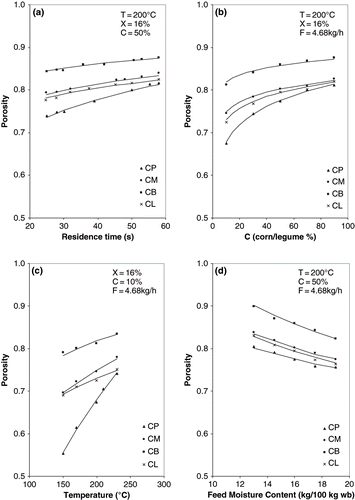
As can be seen, in all extrudates, porosity was increased with temperature. Such a trend had been observed for various extruded products in the past.[Citation6,Citation11,Citation12,Citation15,Citation16,Citation29–32] An increase in the barrel temperature will decrease the melt viscosity. The reduced viscosity effect would favour the bubble growth during extrusion. Moreover, the degree of superheating of water in the extruder would be increased at higher temperatures, also leading to greater expansion.
Increased residence time led to a slight increase of extrudate porosity at all type of corn-legume blends. That is, increased feed rate led to a decrease in porosity (EquationEq. 2). Increased feed rate would influence the degree of fill, inducing the degradation of amylopectin networks, and change the melt rheological characteristics thus leading to greater elastic effect and changes in product porosity. Exactly, a rise in feed rate leads to an increase of final viscosity and consequently porosity decreases.[Citation6,Citation26,Citation31,Citation33,Citation34]
Feed moisture content seems to have an influence to porosity; as it raised porosity decreased. Moisture content during extrusion provides the driving force for the expansion and also contributes to the rheological properties of the melt, which in turn affect expansion. Moisture is the main plasticizer of flours, which enables them to undergo a glass transition during the extrusion process and thus facilitates the deformation of the matrix and its expansion.[Citation35] Similar results have been observed in the past.[Citation13,Citation26,Citation30,Citation31,Citation36,Citation37]
It was observed that increasing the amount of legume, porosity decreased. This trend could be attributed to legume proteins. Proteins have an effect on expansion through their ability to affect water distribution in the matrix and through their macromolecular structure and conformation, which affects the extensional properties of extruded melts. They also contribute to extensive networking through covalent and nonbonding interactions that take place in extrusion.[Citation38,Citation39] Similar results have been observed previously.[Citation40–43]
From , it is clear that the extrudates containing chickpea had the lowest values of porosity and the extrudates containing white bean had the highest value of porosity. This might be due to shortening effect in chickpea blends which exhibit higher lipid content (). A stronger influence on corn/chickpea blend porosity by temperature was observed. Generally differences in values observed among different legume blends could be attributed to differences in legume proteins and especially in protein quality.
The expansion ratio of extrudates is presented in . It is obvious that expansion ratio depends on residence time, extrusion temperature, feed moisture content and corn to legume ratio. More specifically, expansion ratio increased with residence time and temperature and decreased with feed moisture content and corn to legume ratio. It should be pointed out that porosity and expansion ratio were depended in a similar way by the same parameters. This trend is well described by EquationEq. (13). Furthermore, these two properties represent the swelling of the product, so a similar dependence from process variables and material characteristics is expected.
Figure 6 Comparative figures of expansion ratio for all extrudates (CP: corn/chickpea; CM: corn/mexican bean; CB: corn/white bean; CL: corn/lentil). e. Expansion ratio as a function of residence time; f. expansion ratio as a function of corn/legume ratio; g. expansion ratio as a function of temperature; and h. Expansion ratio as a function of feed moisture content.
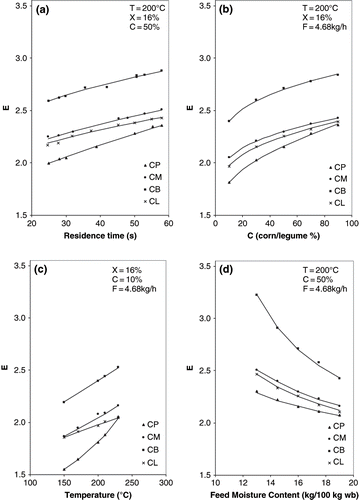
The values of true density for each type of extrudate are shown in . It is evident that the Corn/Lentil extrudate had the minimum value of true density, while Corn/Chickpea extrudate had the maximum value.
Table 5 True density
CONCLUSIONS
Structural properties of expanded corn-legume snacks produced on a twin screw extruder were depended on several process conditions. Extrusion temperature and residence time as well as material characteristics (feed moisture content, corn to legume ratio) had some significant effect on extrudate porosity. Porosity of extrudates was found to increase with temperature and residence time and to decrease with feed moisture content and ratio of legume. A similar trend was observed for expansion ratio. The addition of legumes (protein source) produces more dense products. Comparatively, the usage of white bean in mixtures for the production of snacks, leads to product with greater porosity than those with other legumes.
NOMENCLATURE
| C | = |
Corn/legume ratio (−) | |||||||||||||||||||||||||
| d | = |
Diameter (cm) | |||||||||||||||||||||||||
| d 0 | = |
Die diameter (cm) | |||||||||||||||||||||||||
| E | = |
Expansion ratio (−) | |||||||||||||||||||||||||
| e f | = |
Empty fraction (−) | |||||||||||||||||||||||||
| F | = |
Feed rate (kg/s) | |||||||||||||||||||||||||
| K | = |
Number of experimental measurements (−) | |||||||||||||||||||||||||
| L | = |
Extrudates length (cm) | |||||||||||||||||||||||||
| m | = |
Extrudates mass (g) | |||||||||||||||||||||||||
| M | = |
Number of experiments (−) | |||||||||||||||||||||||||
| N | = |
Screw speed (rpm) | |||||||||||||||||||||||||
| n C | = |
Corn/legume ratio constant (−) | |||||||||||||||||||||||||
| n i | = |
Number of replicates (−) | |||||||||||||||||||||||||
| n N | = |
Screw speed constant (−) | |||||||||||||||||||||||||
| n T | = |
Temperature constant (−) | |||||||||||||||||||||||||
| n X | = |
Feed moisture content constant (−) | |||||||||||||||||||||||||
| n τ | = |
Residence time constant (−) | |||||||||||||||||||||||||
| p | = |
Number of parameters (−) | |||||||||||||||||||||||||
| S E | = |
Standard experimental error (−) | |||||||||||||||||||||||||
| S R | = |
Standard deviation between experimental and predicted values (−) | |||||||||||||||||||||||||
| SST | = |
Total sum of squares (−) | |||||||||||||||||||||||||
| T | = |
Extrusion temperature (°C) | |||||||||||||||||||||||||
| V t | = |
True volume (cm3) | |||||||||||||||||||||||||
| X | = |
Feed moisture content (kg/100kg wb)
| |||||||||||||||||||||||||
ACKNOWLEDGMENTS
The project is co-funded by the European Social Fund (75%) and National Resources (25%)—EPEAEK II—PYTHAGORAS. The authors wish to thank Mr. Panagiotis Mermigas for technical assistance.
REFERENCES
- Avellone , G. , Di Garbo , V. , Abruzzese , G. , Bono , M. , Avellone , G. , Raneli , G. , De Simone , R. and Licata , G. 2003 . Cross-over Study on Effects of Mediterranean Diet in Two Randomly Selected Population Samples . Nutrition Research , 23 ( 10 ) : 1329 – 1339 .
- Panagiotakos , D.B. 2005 . More Evidence that a Healthy Lifestyle Matters: Converting Epidemiology to Policy . Evidence-Based Healthcare & Public Health , 9 ( 2 ) : e1 – e2 .
- Trichopoulou , A. , Lagiou , P. , Kuper , H. and Trichopoulos , D. 2000 . Cancer and Mediterranean Dietary Traditions . Cancer Epidemiology, Biomarkers & Prevention , 9 ( 9 ) : 869 – 873 .
- Tharanathan , R.N. and Mahadevamma , S. 2003 . Grain Legumes—A Boon to Human Nutrition . Trends in Food Science & Technology , 14 ( 12 ) : 507 – 518 .
- Asp , N.J. and Bjorck , I. 1989 . “ Nutritional Properties of Extruded Foods ” . In Extrusion Cooking , Edited by: Mercier , C. , Linko , P. and Harper , J.M. 339 – 434 . St. Paul : American Association of Cereal Chemists .
- Edwards , R.H. , Becker , R. , Mossman , A.P. , Gray , G.M. and Whiteland , L.C. 1994 . Twin Extrusion Cooking of Small White Beans (Phaseolus Vulgaris) . Lebesm.-Wiss.-Technol. , 27 ( 5 ) : 472 – 481 .
- Rackis , J.J. , McGhee , J.E. and Booth , A.N. 1975 . Biological Threshold Levels of Soybean Trypsin Inhibitors by Rat Bioassay . Cereal Chem. , 52 ( 1 ) : 85 – 92 .
- Steel , C.J. , Sgarbieri , V.C. and Jackis , M.H. 1995 . Use of Extrusion Technology to Overcome Undesirable Properties of Hard-to-cook Dry Beans (Phasseolus Vulgaris L.) . J. Agric. Food. Chem. , 43 : 2487 – 2492 .
- Harper , J.M. 1981 . Extrusion of Foods , Vol. 1, 2 , Boca Raton, FL : CRC Press .
- Ahmed , Z.S. 1999 . Physico-chemical, Structural and Sensory Quality of Corn-based Flax-snack . Nahrung , 43 ( 4 ) : 253 – 258 .
- Ali , Y. , Hanna , M.A. and Chinnaswamy , R. 1996 . Expansion Characteristics of Extruded Corn Grits . Lebensm.-Wiss.u.-Technol. , 29 ( 8 ) : 702 – 707 .
- Alonso , R. , Orue , E. , Zabalza , M.J. , Grant , G. and Marzo , F. 2000 . Effect of Extrusion Cooking on Structure and Functional Properties of Pea and Kidney Bean Proteins . J. Sci. Food Agric. , 80 ( 3 ) : 397 – 403 .
- Fernandez-Gutierrez , J.A. , Martin-Martinez , E.S. , Martinez-Bustos , F. and Cruz-Orea , A. 2004 . Physicochemical Properties of Casein-starch Interaction Obtained by Extrusion Process . Starch , 56 ( 5 ) : 190 – 198 .
- Iwe , M.O. 1998 . Effects of Extrusion Cooking Functional Properties of Mixtures of Full-fat Soy and Sweet Potato . Plants Foods and Human Nutrition , 53 ( 1 ) : 37 – 46 .
- Rocha-Guzman , N.E. , Gallegos-Infante , J.A. , Gorzalez-Laredo , R.F. , Castillo-Antonio , P.A. , Delgado-Licon , E. and Ibarra-Perez , F. 2004 . Functional Properties of Three Common Bean (Phaseolus Vulgaris) Cultivars Stored under Acceleraded Conditions Followed by Extrusion . LWT , 39 ( 1 ) : 6 – 10 .
- Sebio , L. and Chang , Y.K. 2000 . Effect of Selected Parameters in Extrusion of Yam Flour (Dioscorea Rotundata) on Physicochemical Properties of the Extrudates . Nahrung , 44 ( 2 ) : 96 – 101 .
- Seker , M. 2005 . Selected Properties of Native or Modified Maize Starch/soy Protein Mixtures Extruded at Vary Screw Speed . J. Sci, Food Agric. , 85 : 1161 – 1165 .
- Sun , Y. and Muthukumarappan , K. 2002 . Changes in Functionality of Soy-based Extrudates During Single-screw Extrusion Processing . Int. J. Food Properties , 5 ( 2 ) : 379 – 389 .
- Yu , J.Z. and Augustine , A. 2002 . Effect of Extrusion Cooking on the Properties and Acceptability of Bread-crumb-like Coating Products . Int. J. Food Properties , 5 ( 3 ) : 573 – 584 .
- Krokida , M.K. , Zogzas , N.P. and Maroulis , Z.B. 1997 . Modeling Shrinkage and Porosity during Vacuum Dehydration . Int. J. Food Sci. Technol. , 32 : 445 – 458 .
- Rahman , M.S. 2003 . A Theoretical Model to Predict the Formation of Pores in Food during Drying . Int. J. Food Properties , 6 ( 1 ) : 61 – 72 .
- Rahman , M.S. 1995 . Food Properties Handbook , 179 – 224 . New York : CRC Press .
- Padmanabhan , M. and Bhattachayray , M. 1989 . Extrudate Expansion during Extrusion Cooking of Foods . Cereal Food World , 34 : 945 – 949 .
- Kumagai , H. , Kumagai , H. and Yano , T. 1993 . Critical Bubble Radius for Expansion in Extrusion Cooking . Journal of Food Engineering , 20 ( 4 ) : 325 – 338 .
- Alvarez-Martinez , L. , Kondury , K.P. and Harper , J.M. 1989 . A General Model for Expansion of Extruded Products . Journal of Food Science , 53 : 609 – 615 .
- Ilo , S. , Tomschik , E. , Berghofer , E. and Mundigler , N. 1996 . The Effect of Extrusion Operating Conditions on the Apparent Viscosity and the Properties of Extrudates in Twin-screw Extrusion Cooking of Maize Grits . Lebensmittel-Wissenschaft und Technologie , 29 ( 7 ) : 593 – 598 .
- Kokini , J.L. , Chang , C.N. and Lai , L.S. 1992 . “ The Role of Rheological Properties of Extrudate Expansion ” . In Food Extrusion Science and Technology , Edited by: Kokini , J.L. , Ho , C. and Karwe , M.V. 631 – 652 . NY : Marcel Dekker .
- Launay , B. and Lisch , L.M. 1983 . Twin-screw Extrusion Cooking of Starch Pastes, Expansion and Mechanical Properties of Extrudates . Journal of Food Engineering , 2 ( 4 ) : 259 – 280 .
- Bhattacharya , S. 1997 . Twin-screw Extrusion of Rice-green Gram Blend: Extrusion and Extrudates Characteristics . Journal of Food Engineering , 32 ( 1 ) : 83 – 99 .
- Ding , Q.B. , Ainsworth , P. , Plunkett , A. , Tucker , G. and Marson , H. 2006 . The Effect of Extrusion Conditions on the Functional and Physical Properties of Wheat-based Expanded Snacks . Journal of Food Engineering , 73 ( 2 ) : 142 – 148 .
- Ding , Q.B. , Ainsworth , P. , Tucker , G. and Marson , H. 2005 . The Effect of Extrusion Conditions on the Physicochemical Properties and Sensory Characteristics of Rise-based Expanded Snacks . Journal of Food Engineering , 66 ( 3 ) : 283 – 289 .
- Chauhan , G.S. and Bains , G.S. 1988 . Effect of Some Extruder Variables on Physico-chemical Properties of Extruded Rice-legume Blends . Food Chemistry , 27 ( 3 ) : 213 – 224 .
- Chang , Y.K. , Martinez-Bustos , F. and Lara , H. 1998 . Effect of Some Extrusion Variables on Rheological Properties and Physiochemical Changes of Cornmeal Extruded by Twin Screw Extruder . Brazilian Journal of Chemical Engineering , 15 ( 4 ) : 370 – 381 .
- Chang , Y.K. , Martinez-Bustos , F. , Park , T.S. and Kokini , J.L. 1999 . The Influence of Specific Mechanical Energy on Cornmeal Viscosity Measured by an on Line System during Twin Screw Extrusion . Brazilian Journal of Chemical Engineering , 16 ( 3 ) : 285 – 295 .
- Moraru , C.I and Kokini , J.L. 2003 . Nucleation and Expansion during Extrusion and Microwave Heating . Comprehensive Reviews in Food Science and Food Safety , 2 : 120 – 138 .
- Garber , A.N. , Hsieh , F. and Huff , H.E. 1997 . Influence of Particle Size on the Twin-Screw Extrusion of Corn Meal . Cereal Chem. , 74 ( 5 ) : 651 – 661 .
- Liu , Y. , Hsieh , F. , Heymann , H.E. and Huff , H.E. 2000 . Effect of Process Conditions on the Physical and Sensory Properties of Extruded Oat-corn Puff . Journal of Food Science , 65 ( 7 ) : 1253 – 1259 .
- Li , M. and Lee , T.C. 1996 . Effect of Cysteine on the Functional Properties and Microstructures of Wheat Flour Extrudates . J. Argic. Food Chem. , 44 ( 7 ) : 1871 – 1880 .
- Madeka , H. and Kokini , J.L. 1992 . Effect of Addition of Zein and Gliadin on the Rheological Properties of Amylopectin Starch with Low-to-intermediate Moisture . Cereal Chem. , 69 ( 5 ) : 489 – 494 .
- Bhattacharya , S. and Prakash , M. 1994 . Extrusion of Blends of Rice and Chickpea Flours: A Response Surface Analysis . Journal of Food Engineering , 21 ( 3 ) : 315 – 330 .
- Mathew , J.M. , Hoseney , R.C. and Faubion , J.M. 1999 . Effects of Corn Hybrid and Growth Environment on Corn Curl and Pet Food Extrudates . Cereal Chem. , 76 : 625 – 628 .
- Onwulata , C.I. , Konstance , R.P. , Smith , P.W. and Holsinger , V.H. 1998 . Physical Properties of Extruded Products as Affected by Cheese Whey . Journal of Food Science , 63 ( 5 ) : 814 – 818 .
- Onwulata , C.I. , Konstance , R.P. , Smith , P.W. and Holsinger , V.H. 2001 . Co-extrusion of Dietary Fiber and Milk Proteins in Expanded Corn Products . Lebens Wiss Technol. , 34 ( 7 ) : 424 – 429 .
